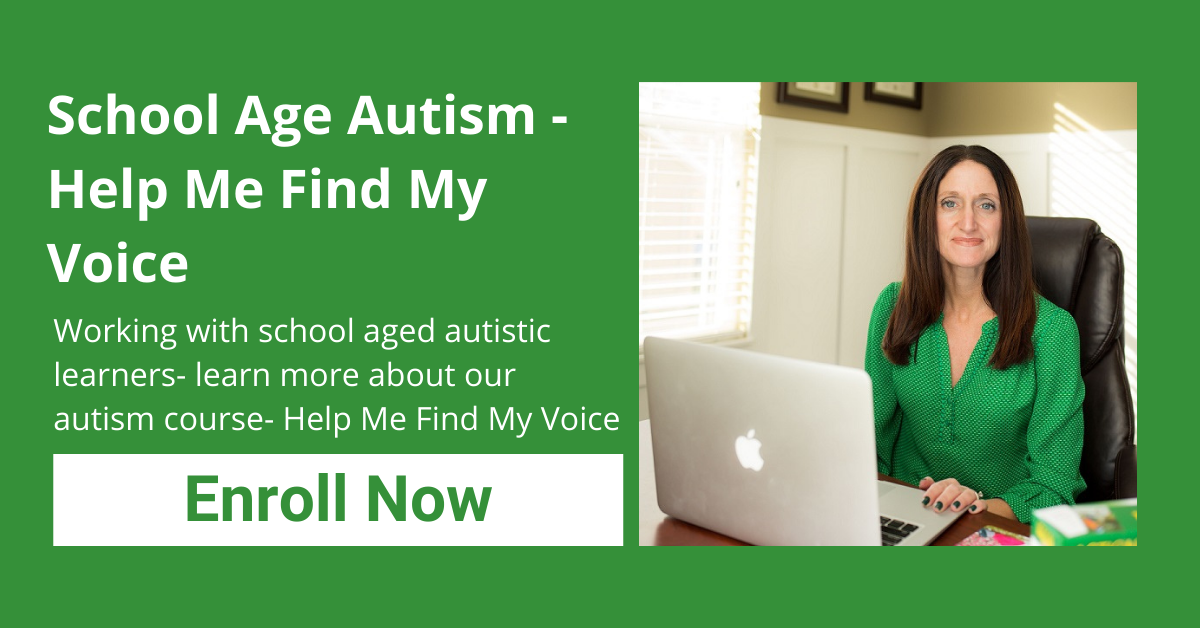“Well, I guess you better figure it out”....
Episode #084: Naturalistic Communication Training with Dr. Cindy Gevarter
https://vimeo.com/735642072
T
here is so much opportunity for communication in our students’ natural environments. But how can we use this intentionally and build our therapy plan around it? Dr. Cindy Gevarter, BCBA-D and assistant professor in the Department of Speech and Hearing Sciences at the University of New Mexico, joins me to discuss real world applications for naturalistic communication training in your therapy sessions.
Assessments
When beginning therapy sessions for students, assessments are important for understanding students skills, goals, and needs. Dr. Gevarter listed several of her preferred assessments for naturalistic communication training that we have talked about on the show many times!
- Communication Matrix
- VB-MAPP
- Early Start Denver Model
Planning
Naturalistic communication is not random play, when preparing for a session keep in mind opportunities, routines, and priorities that are typical for your student. But you can’t just wing it. Dr. Gevarter recommends planning with an Activity Matrix: skills and goals associated with activities and embedded strategies. Follow through with developmental extension, parent coaching, and an environment set up for natural communication. A lot of the strategies and planning we discuss apply directly to 1 to 1 sessions, but Dr. Gevarter elaborates on how to plan for dyads and group settings by intentional peer to peer interaction or typical routines such as circle time or an art activity.
Data
In a natural environment, we can’t pause a student while we record data. Dr. Gevarter suggests simplifying your data for quick observations. You may try using a rating scale or other shorthands that you can understand when noting responses, and goal planning. Remember that this is informal data collection used to inform your sessions, don’t overcomplicate it!
Why Natural Environment?
I often find parents in in-home sessions surprised that our therapy isn’t taking place at a table with structured activities. While there is a time and a place for the table, there is a major benefit to utilizing a student’s natural environment. When participating in natural play or natural environment activities, students are seeing and receiving natural reinforcement from their communication. They can actually see and experience the benefit of communication.
#autism #speechtherapy
Today’s Guest:
Cindy Gevarter Ph.D. is an assistant professor in the Department of Speech and Hearing Sciences at the University of New Mexico (UNM). She received a B.A. in psychology from the University of Virginia (UVa), an M.T. in special education from UVa, and a Ph.D. in early childhood special education from the University of Texas at Austin. Dr. Gevarter is a certified special education teacher as well as a board certified behavior analyst at the doctoral level (BCBA-D). Gevarter’s research and teaching interests focus on communication intervention and assessment for young children with autism spectrum disorder and related disabilities. Her research has focused on augmentative and alternative communication, naturalistic early communication intervention, and communication partner training for early intervention providers and parents. She is the Program Director of Project SCENES (Social-communication: Collaborating Early with Naturalistic, Evidence-based Supports), an interdisciplinary grant that will fund and train speech-language pathology and special education masters students interested in autism.
What’s Inside:
- How can we adapt the natural environment of our sessions for communication?
- How to use an embedded approach for natural communication.
- Using naturalistic training in 1:1, dyads, and group sessions.
- Real world opportunities for your next therapy session.
- How to simplify data collection for observation in a natural setting.
- What are preferred assessments for naturalistic communication training?
Mentioned In This Episode
—Cindy Gevarter, Ph.D., BCBA-D
—Collaborative Autism Grant
—Project SCENES
—ABA Speech: Home
—Start Communicating Today
—Help Me Find My Voice
Rate, Review & Subscribe
If you found this podcast helpful, please consider rating and reviewing my show! This helps me to support support more people — just like you!
If you have not done so already, subscribe to the podcast. This ensures that you do not miss an episode!
Listen on
Apple Podcasts
Listen on
Stitcher
Subscribe
via Email
You Might Also Like…
Episode #185: Replay: The Power of Joint Attention
Enjoy this replay from episode 62. Joint attention is...
Episode #184: 5 Tips For Dealing With Contentious IEP Meetings
Conflict is part of what we do...

